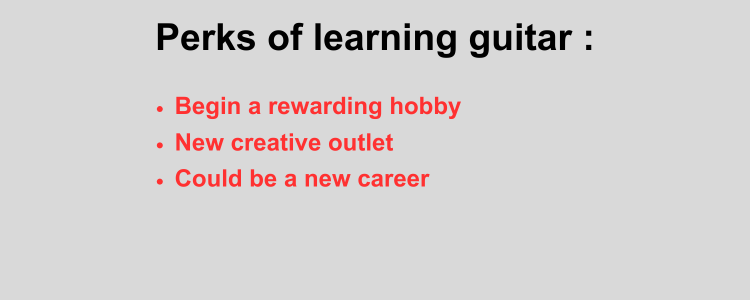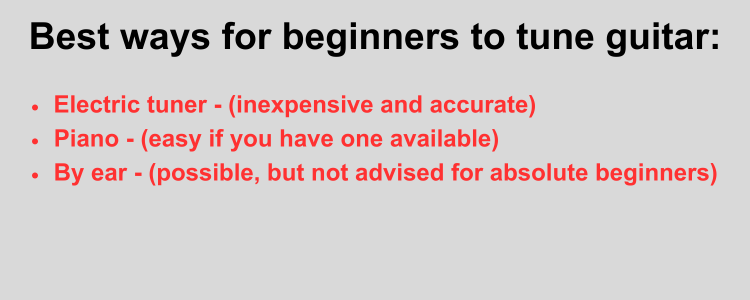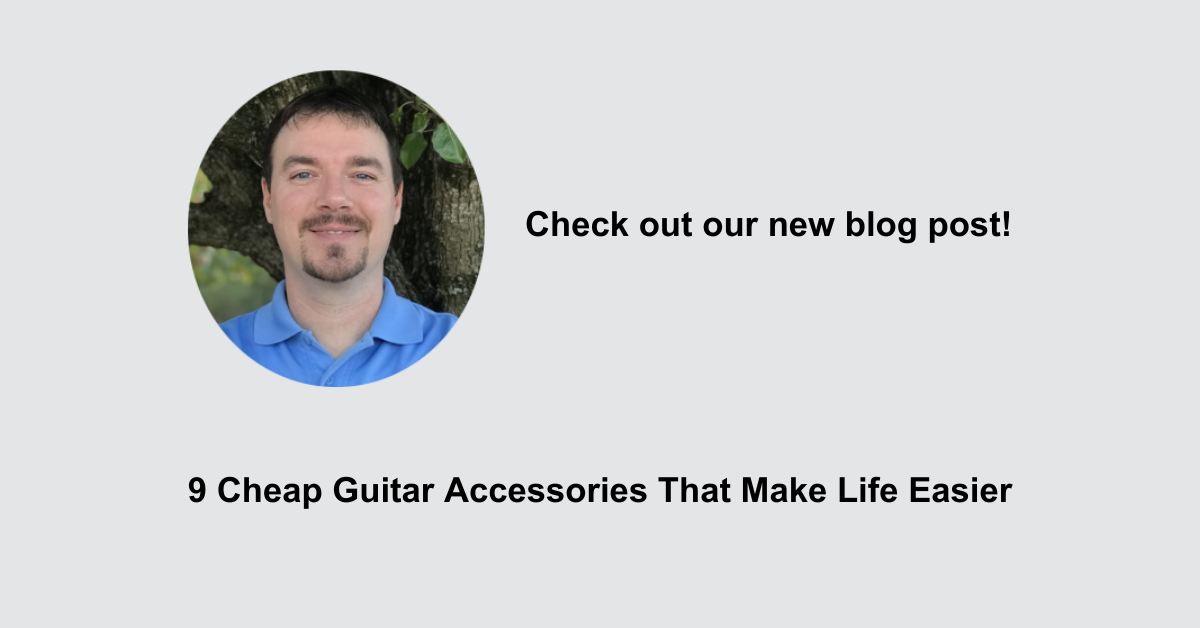Congratulations on your decision to learn to play guitar! You have chosen a gratifying hobby, past-time, and or career. That’s right, guitar playing can become whatever you make of it. You may not know the cheap guitar accessories to help you get started. Beginners usually don’t.

A few things make the whole process much easier for beginners. That’s where this article comes in and makes your life easier. We’ll tell you exactly what those essential accessories are and how to get them.
Learning to play the guitar can be tough and frustrating.
That’s why I’ve compiled this list of guitar accessories that help along that process.
Now, let’s get to that list!
Accessory #1 – Get Yourself A Tuner
The first thing any guitarist should do before playing the guitar is tune it. Playing an out-of-tune guitar is unacceptable to an audience, and it should be unacceptable to the performer as well!
The truth is any instrument that is out of tune is unpleasant to the ear. Your listeners will run away if you are out of tune.
It is a must that you own a small tuner. It is one of the most essential guitar accessories!
Yes, there are other ways to tune a guitar, such as a tuning fork or a piano. For the novice, buying a reliable tuner is easier and faster.

Here are the top three tuners I would suggest for a beginner:
Let’s discuss them some more!
First Choice – Korg CA-50 Chromatic Tuner
This is a reliable tuner used for acoustic and electric guitars. You can pick various tunings such as Standard, E Flat, etc…
It’s portable, accurate, and dependable.
Second Choice – Korg PitchCrow-G Clip-On Tuner
I’ve loved this little guy from the first time I used it. It’s easy to use, easy to see, and accurate. In short, it works great and does what it’s supposed to do. Allows you to tune in silence, or while playing.
Third Choice – Boss TU-3 Chromatic Tuner Pedal
When playing an electric guitar, a floor tuner might be best. The Boss TU-2 is built like a tank and will not let you down.
Accessory #2-Picks
Picks are an essential part of playing guitar that some may not consider them an accessory. They are a key necessity for playing guitar. There is no one-size-fits-all when it comes to guitar picks. It is up to you what feels the most comfortable. There are various thicknesses and sizes you should try out though.
They range from heavy to thin generally speaking. Heavy being the thickest and stiffest, and thin being the lightest. You should buy and experiment with all kinds of picks.
Guitar pick thickness:
- Heavy
- Medium
- Thin
You should have at least two of each thickness: heavy, medium, and thin. Different grips are offered as well. I like the Dunlap nylon grip picks myself.
I also use Fender medium picks often. They are thin enough for strumming and thick enough for picking.
Don’t bother ordering off the internet until you know what you like. Stop in at your local pawn shop or guitar shop and chances are you find a decent selection.
Accessory #3- Chord Book
A good chord book is a necessity for guitar players of any level. In the beginning, a focus on learning chords is a must. Learn the most common major and minor chords in guitar music.
“Mel Bay Guitar Chords” – This is the best-selling guitar chord book of all time. You will learn major, minor, 6th, 7th, and 9th chords, as well as movable rhythm (barre) chords.
Another solid option is “The Guitarists Chord Book” by Peter Vogl.
Whichever book you decide on, dive into it and try to learn and use as many chords as possible. Learning chords is an essential part of being a rhythm guitar player.
It would be best if you practiced the technique and correct fingerings first. Then, practice switching between different chords. Start with the most common major and minor chords first.
When you are good at strumming chords, you will be valuable in a musical setting with other musicians.
Accessory #4- Metronome
Counting is a big part of playing music. Not that you have to be great at math or anything like that. Being able to count to ten is about the gist of it.
That’s where metronomes come in. They help us count with a steady meter.
While learning, it helps to have the metronome provide the meter for you while you count along with it.
Many people think they have great rhythm while their meter is all over the place. They are speeding up and slowing down without realizing it. This is where the metronome helps most.
If you ever plan on making a recording, you should try to get used to playing along with a metronome. You must learn to count while you play. Using a metronome during practice will help develop your internal clock.
You don’t have to spend much money on these. You may already have one on an app for free on your smartphone. If you own a digital piano, you may find that it has a programmable metronome. You could even download one for free from the App Store.
I like to use this small Wittner metronome.
Whichever you decide to do, get one and use it. You won’t use it when performing live, but you should always use it when practicing. Use it when learning new material and recording in your home studio, or any recordings you make.
Accessory #5- Method Book
I don’t tell people to trust the internet to teach them how to play the guitar. The internet is wonderful, but a structured path is the better way to go. It would be best if you had a simple, tried-and-true method book. A good method book is one of the most essential guitar accessories. These method books teach you the basics about your instrument and the rudiments of music.
Some experienced players may disagree and say that a method book is unnecessary.
While they may have some points, I will still disagree and recommend that you start with one anyway.
Here’s why:
Reason 1: Great method books use tried and true guitar pedagogy. This means they might be tough to get through, but you will learn to play if you complete it.
Reason 2: Method books present the basic rudiments of music. Some people refer to these basics as the mundane and boring part of learning your instrument.
So, if you find learning the essential parts of playing music boring, playing the guitar may not be for you.
It’s better to find this out early in the process.
I recommend the following method books:
- “Hal Leonard Guitar Method“
- “Modern Guitar Method” Mel Bay
- “Mastering The Guitar” Mel Bay
- “A Modern Method For Guitar” by William Leavitt
Let’s talk about them some more!
Easiest – For the hobbyist
Hal Leonard Guitar Method – This is a three-book series that is easiest for a complete beginner. No need to complete all three books right now though. Learn Book 1 and you will be off to a great start!
Mel Bay Modern Guitar Method – This is a seven-book series that is quite popular. It is a little more challenging than the Hal Leonard method. No need to worry about completing all seven books. Do book 1 for now and you’re cooking.
A Bit More Challenging – For serious students/college-level
Mel Bay “Mastering The Guitar” series – There are six books in this guitar method. Used as the standard method at some colleges. This series is thorough and can be quite challenging.
It contains a vast amount of material. Beginners should try to complete Books 1A and 1B.
William Levitt’s “A Modern Method For Guitar”. – another method used in college curriculums including the Berklee College of Music.
It is a three-book series that will challenge players of all levels. What makes this one so challenging is the original material used to explain the concepts. You will not find folk and spiritual tunes as you would in the Mel Bay and Hal Leonard books.
Accessory #6-Polish Clothes/wipes
You’ll need to wipe off the strings after you play. The oil and dirt from your fingers will rust steel strings. Plus, dead skin cells and dirt from your fingertips are gross.
For this, I use a plain washcloth (dry). Do not wet the washcloth or put water on your instrument for any reason. During string changes, I will give the entire fretboard a good wipe-down while the strings are off. I give a lot of attention to the frets themselves.
To remove fingerprints and smudges, you will want to use a less abrasive polish cloth. Walmart is a cheap place to find these.
Or often you may find them at your local pawn shop or music store. Polish away fingerprints and smudges using a circular motion and elbow grease.
Take your time and be patient. This is a time to pamper your guitar and admire it.
Accessory #7- Capo
A capo is a device that you put on the neck of the guitar to raise the pitch (shorten the length of the neck). It is often used by players to change a song into a key more suitable to their vocal range.
You squeeze it open and put it where you want it. There are other styles of Capos and you can choose what suits you.
Kyser Capo is a very reliable and popular capo that will not let you down. They come in all kinds of different colors so you can pick one that suits you with no problems. They are inexpensive (usually between $15-$20) and will last for ages.
Accessory #8- Strap
There are many options to choose from here. It’s safe to say you don’t have to start with anything fancy. Pick something that is the right size and a comfortable fit.
The only rule for a strap is that it holds onto your guitar and does not let it drop to the floor. Straps are only necessary if you will be playing while you stand.
Complete beginners will sit while they are learning to play. It is a good idea to switch things up and attempt to get used to playing while standing.
Later on, when performing, most people will expect you to be standing. One suggestion I have is not to let the guitar hang down low when you play standing up.
Adjust the strap to where the guitar is in the same position as it would be when you are sitting and playing.
Accessory #9- Finger Ease
Finger Ease is a product that you spray on the strings that helps lubricate them. It also helps condition and protect the strings and fretboard. Finger Ease will allow you to play longer before the fingers get sore.
When you are starting to play, your fingers will become very tender. Anything that can help your fingers slide across the strings with less friction is a plus. There are of course other brands and products that do the same thing so you can pick the one you like.
If you do this, along with wiping your strings with a cloth after playing, you will get a lot more life from your strings. As a bonus, your instrument will stay cleaner.
Conclusion
So, there you have a list of nine essential guitar accessories that a beginner should have. These are not everything a guitarist will ever need, but will serve you well as a starting point.
You will pick up many accessories and learning resources as your skills increase. Many guitar players, including myself, have a large library of learning materials.
But for now, you should use the recommended accessories to speed up your learning process. Another resource that can help you is our 12 Guitar Chords for Beginners post. The classical guitarist may find this classical guitar accessory page helpful as well.
Go ahead and bookmark this post for your reference, and share it if you found it useful!
Don’t forget to join our mailing list!
See you in the next post!

